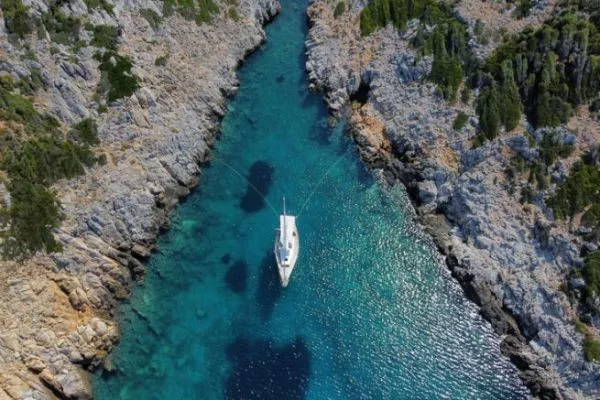Mooring in Mediterranean Waters
Mooring ashore is a widely practiced technique in the vibrant Mediterranean region. With various methods available, understanding the benefits and limitations of each is essential for ensuring a smooth experience when docking your vessel.
The Need for Shore Mooring
In many splendid Mediterranean coves, the sheer number of boats necessitates innovative mooring solutions beyond the traditional systems. This is particularly true in popular destinations such as Greece, Turkey, and parts of Italy, where the practice of using mooring lines from land is commonplace. The central question that arises is: what is the best choice—floating ropes or webbing? Each option offers distinct advantages and considerations, influenced by factors such as material durability, wind conditions, and mooring practices.
Webbing or Floating Ropes? Key Differences
Webbing is favored for its compactness and ease of setup. A key advantage is the retractor which remains consistently in place at the rear of the vessel, facilitating quick handling. However, it can also present challenges; for instance, webbing tends to sink and can flap noisily in the wind, not to mention the difficulties in releasing it under tension.
On the other hand, floating ropes, typically crafted from flexible polyester, enhance maneuverability. They float, hence are less prone to getting entangled in the propellers, and can be prepared in advance. However, they are more susceptible to UV damage and require proper storage. Crafting a balance between these two options often leads sailors to keep both on hand—optimizing speed with webbing for short stops while relying on floating ropes for longer-lasting stability.
Challenges of Onshore Anchoring
In regions where several boats congregate in tight circumstances, the use of shore mooring lines becomes almost obligatory. Areas like congested Greek coves require robust mooring solutions to keep vessels properly aligned, especially in the face of shifting winds. A skilled crew is essential for setting these lines, yet they serve a crucial role in preventing collisions and maintaining order amongst many boats. Thus, understanding the local practices is paramount to enjoying a seamless experience.
Choosing the Right Materials and Maintenance
The choice of mooring line extends beyond type to include material and diameter. For example, for a 12-meter sailboat, selecting a floating rope of approximately 15mm diameter is often recommended. Soft polyester offers better handling than its rigid counterpart, polypropylene, which can cause chafing. To protect the mooring lines from sharp rocks, using a short chain ring can prove invaluable, with a five-meter loop of chain wrapped around a boulder ensuring reliable anchoring.
| Тип | Преимущества | Disadvantages |
|---|---|---|
| Webbing | Compact, easy to set up | Can sink, noisy under wind |
| Floating ropes | Maneuverable, floats | Requires storage, UV damage risk |
Proper Management of Mooring Lines
Effective handling of these mooring lines ultimately determines success during your anchoring efforts. Many sailors opt for basins to store long lengths of lines, ready to be deployed by swimmers or a tender. The buoyancy of floating ropes makes retrieval accessible even for novice crew members, while webbing requires careful unwinding to avoid becoming tangled.
Regulations and Best Practices
In various Mediterranean locales, there are regulations dictating the type of mooring lines allowed, particularly in Greece where bright yellow or orange floating ropes are mandated to enhance visibility and provide a safeguard against collisions. While other Mediterranean regions may not adhere to strict regulations, local customs typically promote safety standards—minimum lengths of 50 meters for mooring lines and the complementary use of chains being commonplace.
Exploring Local Culture through Sailing
Understanding how to moor your vessel effectively not only enhances your sailing experience but also provides insights into the local culture and geography. Each port of call presents its own unique charm; the culture, nature, and rhythm of life reflect in the waters you navigate and the inlets you explore. When sailing the stunning Mediterranean, this multifaceted journey encompasses not only the landscapes and architecture but also the myriad of local customs tied to maritime practices.
Planning Your Next Adventure
As planning a trip to the sea approaches, consider the benefits of renting a boat or yacht to fully embrace unique regions steeped in history and natural beauty. You will discover that each inlet, bay, and lagoon tells its own story—just like the local cuisine and architecture—and makes for an unforgettable experience on the water. By taking advantage of platforms like GetBoat.com, it becomes easy to customize your adventure according to personal taste and budget.
As you navigate through your next sea-bound endeavor, remember that the decisions made surrounding your mooring options are pivotal to enjoying a seamless and enjoyable sailing experience. The Mediterranean’s captivating waters invite exploration, and the right mooring solutions ensure your journey is both adventurous and safe. Join the community of boat enthusiasts and let GetBoat simplify the process of booking your next unforgettable maritime escape. Ultimately, the allure of the sea beckons for all who wish to embrace its open horizons and captivating escapades.
Renting a boat opens avenues to charting new routes and savoring the exquisite destinations awaiting you on the Mediterranean coastline. From the vibrant markets to the striking scenery, navigating these waters is a delightful blend of experiences that connect you with the essence of each location. If you’re thinking about your next coastal expedition, remember that each sailing destination holds the promise of joy, adventure, and discovery. Visit GetBoat.com to unlock these adventures at your fingertips!


